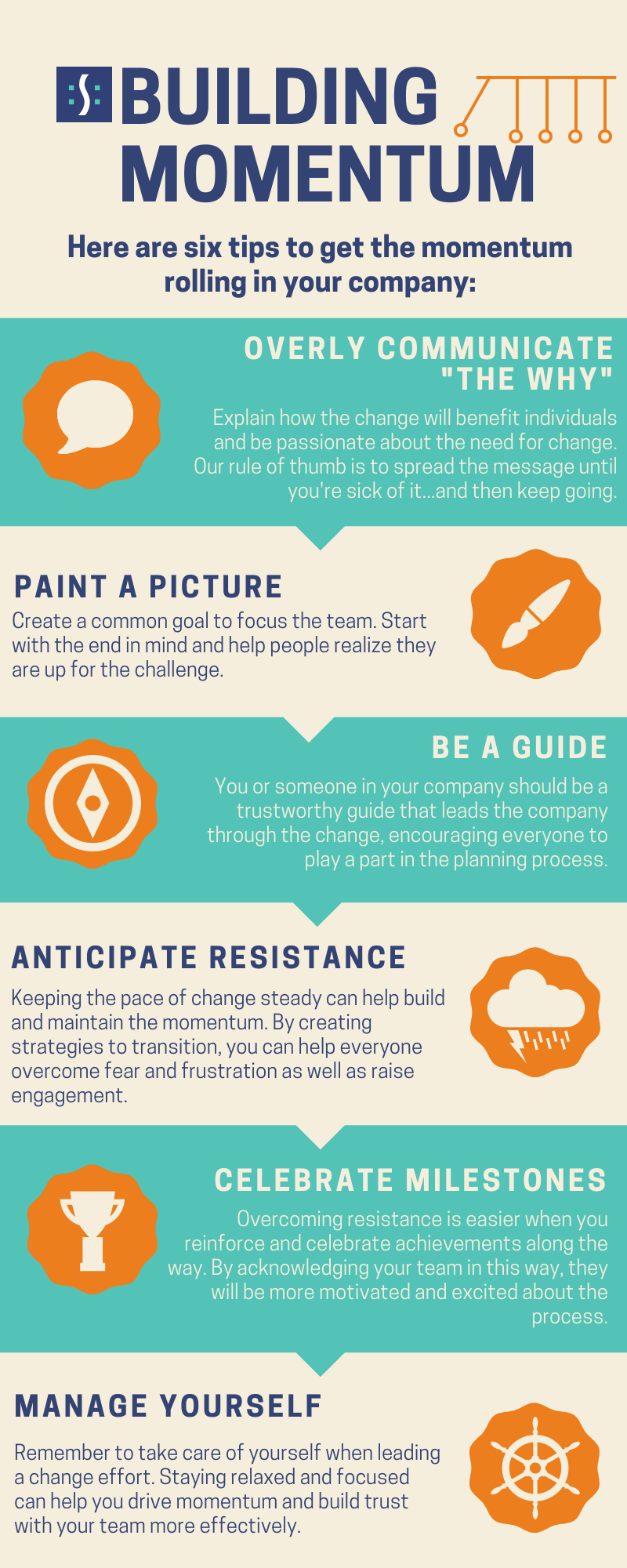
In this 24/7 business world of competing messages and priorities, getting and keeping peoples’ attention long enough to institute a new initiative or make a strategic or cultural shift is no small task! To give yourself at least a fighting chance, you have to be good at building and sustaining momentum and leveraging powerful business relationships.
Momentum in Action
All around us, we can see how momentum influences outcomes. We see tangible examples of momentum in the forming and breaking of waves, the gathering and building of storm clouds, and the building of a sales pipeline that accelerates business growth.
In more intangible ways, we see the power of momentum in the rise or fall of someone’s reputation or a company’s brand, the rapid spread of bad (and good) news, and the development of trust in a new product.
Unsurprisingly, momentum also impacts business results. Researchers concluded that momentum-powered firms deliver 80% more shareholder value compared to those without the extra push. In this same study, it was found that these efficient firms had 93% higher revenue growth and a 58% advantage in earnings growth.[1]
Momentum and Change
When I think of building momentum, I often think of the Greek King Sisyphus, who was condemned to eternally rolling a boulder up a hill, only to see it roll back down.
Too often, I, and others, have experienced that frustration, and it is maddening. The only way to avoid that agony is to make certain we have enough power to get the rock to rest on the top long enough so that it stays there.
Initiating change or a strategic/cultural shift is a tough business, and building momentum is fundamental to getting the change to stick. Momentum keeps the change from “petering out” and from wearing people down. The common business term “program of the day” has arisen from people experiencing change initiatives that failed because they lacked momentum, leaving people feeling as though they had gone through turmoil for nothing.
After a couple of such experiences, most become cynical. As a result, new change initiatives in a company face greater uphill battles than the early ones.
So how can we build enough momentum to get us to the top? Here are some things I’ve learned about building momentum:

Six Tips for Building Momentum During Change
1. Clearly and widely communicate “the why”.
“Why do we need to change? What’s wrong with continuing in our comfortable routines? So, the company and shareholders will make more profit? Who cares! What’s in it for me, the one who has to make the change?”
Explaining how this change will benefit individuals, the company and the customers is critical. The more closely you can tie the benefits to the individual, the sooner you can begin building momentum. The more passionate you can legitimately be about the need for change, the better. Then stay the course.
If they see you falter in your resolve, you (and they) are in for a very tough time.
2. Paint a compelling picture of what people are moving from and what they are moving toward.
For most, it helps to start with the end in mind.
What will success look like? How long will it take? How wide is the gap? How much effort is this going to take?
Will this require me to walk, run a marathon or must I become a triathlete? Setting reasonable expectations—and helping people realize they are up to this task—propels things forward. It energizes people by creating a common goal and team focus.
3. How are we going to get there?
People need to know you have a plan for this journey. You or someone in your company will be their guide, and they had better trust the guide. If not, they will give up or rebel.
Although most people don’t seek out change, the thing they hate is “being changed”. Change goes better if people feel they have some input into the process. You may be their guide, but they have to pack the bags and haul the load so legitimately being included in the planning process increases momentum. Haphazard or staged, inauthentic-inclusion processes will slow you down – and most likely backfire.
4. Anticipate and plan for ways to work through the natural and inevitable inertia and resistance along the way.
Change feels unnatural, so working through the change process requires focus and reinforcement.
When the pace of the change is too fast, people can feel overwhelmed or frightened. At that point, their energy starts to dwindle. If the process is too slow, the boulder rolls down the hill and the task can seem overwhelming. Keeping things moving steadily forward and keeping eyes on the prize will build and maintain momentum.
To do this, you will need to anticipate and prepare for inertia and resistance.
By carefully creating strategies to move everyone past the fear and frustration underlying resistance, you will raise confidence and engagement. Successfully getting through the rough spots can re-energize your team and make the journey worth it.
5. Acknowledge and celebrate progress along the way.
Reinforcement is key to building and maintaining momentum. The relapse syndrome is powerful. Psychologists tell us the time it takes to develop a new habit depends on how engrained the old one is. Thus, it is almost always easier to move back into our comfort zones than move forward into the unknown unless we are highly motivated to do whatever it takes to overcome that resistance.
Reinforcement and celebration are powerful motivators that can drive momentum. Staying focused on reaching the goal with everyone on board helps people overcome resistance. Help people learn from mistakes and breakdowns, but stay focused on recognizing achievements.
6. Manage yourself.
No one wants or trusts a guide who is too tired, stressed or overburdened. If you are responsible for leading change, start by getting your own house in order. If necessary, do something irrational like taking a longer, truly relaxing vacation at least BEFORE you begin the journey. (I strongly advocate bookend vacations with a change process, but then I have learned their power to restore and renew.)
Find people you trust to help you recognize those times throughout the change process when you have become too frustrated, tired and or discouraged, and let them help you work through it. You need support just as your team or organization does.
I submit that by taking care of yourself and staying centered, rested and focused, you will be much better able to drive the momentum needed to make the change and get it to stick.
And then you can really celebrate.
[1] The power of momentum: Companies that build their wave and ride it. (n.d.). Knowledge@Wharton. Retrieved from http://knowledge.wharton.upenn.edu/article/ the-power-of-momentum-companies-that-build-their-wave-and-ride-it/
Photo courtesy of Sebastiaan ter Burg.




